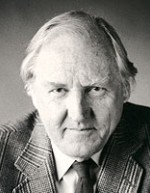
View Professor Mervyn Paterson's photo gallery
You can order the DVD from the Academy for $15 (including GST and postage)
Professor Mervyn Paterson was interviewed in 2006 for the Interviews with Australian scientists series. By viewing the interviews in this series, or reading the transcripts and extracts, your students can begin to appreciate Australia's contribution to the growth of scientific knowledge.
The following summary of Paterson's career sets the context for the extract chosen for these teachers notes. The extracts highlight Paterson's work in rock deformation experimentation and his motivation to build precise instruments for his experiments. Use the focus questions that accompany the extract to promote discussion among your students.
Mervyn Paterson was born into a wheat farming family in 1925 at Booleroo Centre, South Australia. Until 1936 he attended the local primary school, completing primary school when his family moved to the Adelaide Hills. Paterson went to Adelaide Technical High School and attended night school. In 1943 he received a Bachelor of Science (Engineering) from The University of Adelaide.
Paterson began his career at the CSIR Division of Aeronautics working on the physics of metal fatigue, a foundation which shaped his entire career. He left Australia on an Angus Engineering Scholarship to study for a PhD from The University of Cambridge in the UK on X-ray diffraction effects of deformation metals and pursued postdoctoral studies in Chicago in the USA. He returned to work at the newly-named CSIRO, but in 1953 moved to the Australian National University, where he stayed for 31 years in the Research School of Earth Sciences. During this time he developed instruments to test rock deformation, which subsequently led to a 'second career' as owner and manager of Paterson Instruments Pty Ltd, a company specialising in building scientific instruments.
In 1972 Paterson was elected to the Fellowship of the Australian Academy of Science.
In 2003 he was awarded the Centenary Medal for service to Australian society and materials science.
In 2004 he was awarded the Walter Bucher Medal from the American Geophysical Union.
I think it is fair to say that your research work is characterised by asking critical questions and then designing experiments in search of the answers. Can you give us an example or two of that?
Well, take for example the crystallographic preferred orientation in marble. Marble is made up of crystals of calcite and in many cases the crystallographic axes are lined up, they're not just random. It is thought that they are lined up during the deformation. In the lab we can put pieces of marble – calcite aggregates – into the apparatus and deform them, and then use X-rays and so forth to measure the preferred orientation. In that way you can actually relate the preferred orientations that you see in a marble specimen to the sort of deformation that it has had. That enables you to go into the field, pick up a piece of marble and say, 'That's probably been deformed in this way.'
Can you tell us something about your time since formal retirement? I say 'formal' because I know that you have not gone fishing but have developed a new career as a builder of scientific instruments.
Well, I had many research students and sabbatical visitors over the years who used the high-pressure equipment that I'd designed and had built in the lab, and they seemed to manage it quite well. It seemed to me that the equipment was reasonably user friendly, and I knew there was very little such equipment about.
I am talking about equipment for deforming rocks at high temperature and high pressure. It is basically a pressure vessel, a big cylinder of steel, in which one I am talking about equipment for deforming rocks at high temperature and high pressure. It is basically a pressure vessel, a big cylinder of steel, in which one generates a high pressure. The pressure medium is argon gas, and when you pump that up to 3000 or 5000 atmospheres it has about the density of water – that is really high pressure for a gas. Inside the pressure vessel you have a furnace which raises the temperature to 1000° or so. In effect, you operate a mechanical testing machine in that environment, applying directed stresses to the piece of rock so that you can plastically deform it. Then you have to measure the forces involved, and we do that inside the pressure vessel so as to avoid problems with friction and pistons.
That took many years of development. I was conscious that although a number of people over the years had set out to build such machines, many had never worked, so I thought that there was room for one that it was viable. So before I actually retired I had the idea that we might go commercial with it.
Select activities that are most appropriate for your lesson plan or add your own. You can also encourage students to identify key issues in the preceding extract and devise their own questions or topics for discussion.
© 2025 Australian Academy of Science